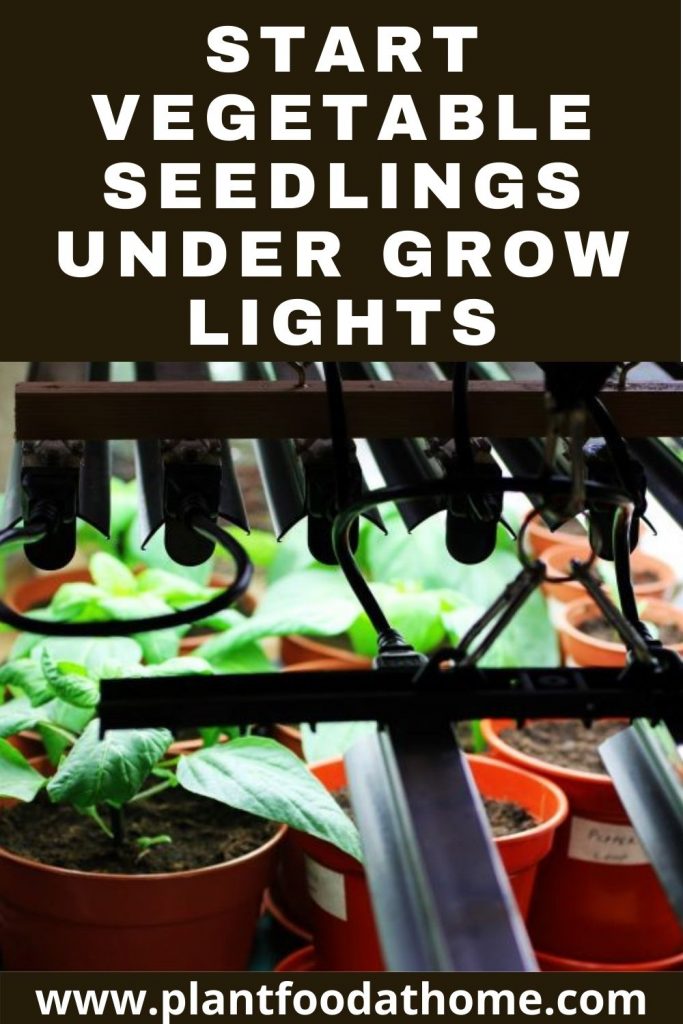You may have seen some intermediate gardeners use grow lights before, but what are they all about? In this article, we’re going to be taking a deep look at grow lights: how they work, what grow lights are best for starting vegetable seedlings, and how to effectively use them. Find out how to start vegetable seedlings under grow lights with these easy-to-follow steps.
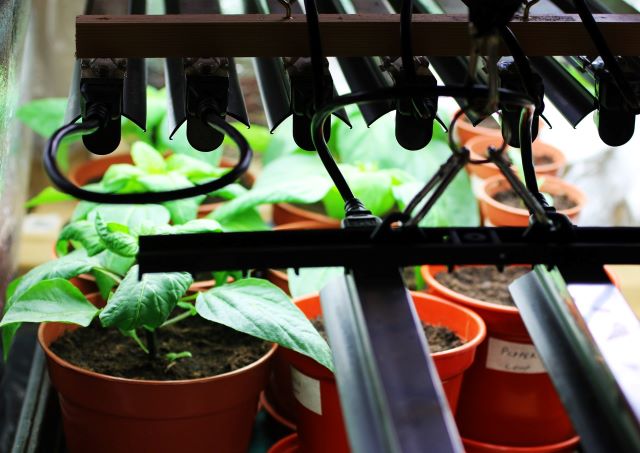
Table of Contents
- How to Use Grow Lights for Vegetable Seedlings: Step-By-Step
- What Are Some Recommendations for Grow Lights?
- The Benefits of Using Grow Lights
- How Grow Lights Affect Plant Growth
- What Color Grow Lights Should I Use?
- Are LED Lights Good for Seedlings?
- What Grow Lights Should You Use For Vegetables?
- How Many Hours A Day Should Seedlings Be Under Grow Lights?
- When Should You Stop Using Grow Lights?
- Frequently Asked Questions
- Conclusion
- Recommended Products:
- Further Reading
How to Use Grow Lights for Vegetable Seedlings: Step-By-Step
1. Decide on your growing location
Deciding where to put your grow light set up is usually determined by available space. Many people like to set up in a garage, or an unused room in the home. Consider a place where emerging seedlings won’t be disturbed by curious pets or children. Importantly, you will also have to consider access to a power outlet to plug in your lights and seedling heat mat.
2. Set up your grow lights and heat mat
Most grow light kits you purchase will come with a handy set on instructions on how to set up your lights. Remember, they’ll need a power outlet. If the area you are setting up is not heated, I would also recommend a seedling heat mat. A heat mat will warm the soil. Seeds will not germinate until the soil is the correct temperature.
3. Sow your vegetable seeds
Begin sowing your vegetable seeds. Use a seed starting tray, or small pots. Sow your vegetable seeds in quality seed-raising soil accordingly. Give the new seeds a gentle water and place them in their growing position under the grow lights. Some gardeners also use a plastic lid to cover the seed trays or pots to increase humidity and assist in seed germination.
4. Maintain your seedlings as they grow
Keep your grow lights on for about 12 hours each day to replicate the amount of light they would receive if they were growing outdoors. If your grow lights are not automated, you can either use a timed power strip to keep track of this, or even set alarms on your phone to remind you when to turn your lights on and off. Turning the lights off is just as important as turning them on to allow for the necessary respiration for healthy plant growth.
5. Maintain watering and air flow
Just like any plant, you’ll need to water regularly. This is especially important for seedlings. A mister or spray bottle will gently water the seeds and newly germinated seedlings without disturbing the soil. If you are using a plastic lid or cover to help the humidity, be sure to open the vents or take the lid off for an hour or two each day for regular airflow.
6. Start hardening off your seedlings
Once the weather has warmed and about a week before you would like to transplant your vegetable seedlings, you can start the process of hardening off. Make sure the seedlings have at least two sets of true leaves first. During the daytime, take the seedlings outside for an hour or two and allow them to acclimate to the outdoor conditions. Keep increasing the time outdoors every day until your seedlings are strong enough to withstand a whole day outside.
You can read more about hardening off seedlings here.
7. Plant your vegetable seedling outdoors
After the vegetable seedlings have been properly hardened off and acclimatized to outdoor conditions, you can transplant your seedlings to their final destination.
What Are Some Recommendations for Grow Lights?
Here are some links to great grow lights:
This grow light set up from iGrowtek is a perfect beginner-friendly grow light kit. It comes with all the fixings; a tray, a light stand (which is height adjustable), and LED lights. All of which is a recipe for success for amazing vegetable seedlings.
Super Sprouter Deluxe Propagation Kit
These grow lights are fluorescent, which I find to be a step down from LED. However, I think this overall package is an unbeatable deal for your wallet! This package comes with everything you need for a grow light set up at an affordable price. Included are lights, a humidity dome, and a spill tray. They even have a convenient booklet to get you started.
This grow light from Briignite is a high-efficient LED light system that is perfect for starting your vegetable seedlings. It is worth noting while this does not come with a set up and the extra perks the other two options have, you’re still getting a very quality product.
The Benefits of Using Grow Lights
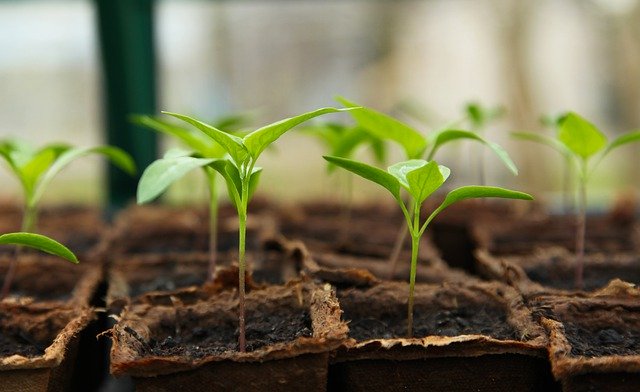
Grow lights produce artificial lighting to simulate sunlight. The artificial light is effective in mimicking sunlight to start seeds and grow plants indoors. Vegetable seedlings started indoors under grow lights, along with a seedling heat mat, will germinate earlier than they naturally would outdoors due to unfavorable outside temperatures.
Vegetable seedlings grown indoors under grow lights are then ready for transplanting outdoors at the beginning of the growing season. This gives gardeners a head start to the season. So instead of planting seeds at the beginning of spring, for example, gardeners can be planting 6-8 week old vegetable seedlings instead. With this head start, you can then see how older seedlings will then go on to mature and produce a crop sooner.
How Grow Lights Affect Plant Growth
So, you might be wondering, how exactly do grow lights work? Grow lights’ most basic purpose is to mimic the effects of the sun’s rays. As we know, sunlight is crucial for growing plants. And although not the real thing, grow lights come close to providing the necessary light for growing healthy plants.
So let’s get a little bit sciency for a second here. All forms of light, fall on a spectrum. The spectrum is measured in nanometers, which corresponds to a wavelength of light. Humans can physically see the 400-700 nanometer range – this is what we call visible light, or Photosynthetically Active Radiation (PAR). I told you it was sciency, let’s carry on.
So these wavelengths of light are used by plants to undergo photosynthesis.
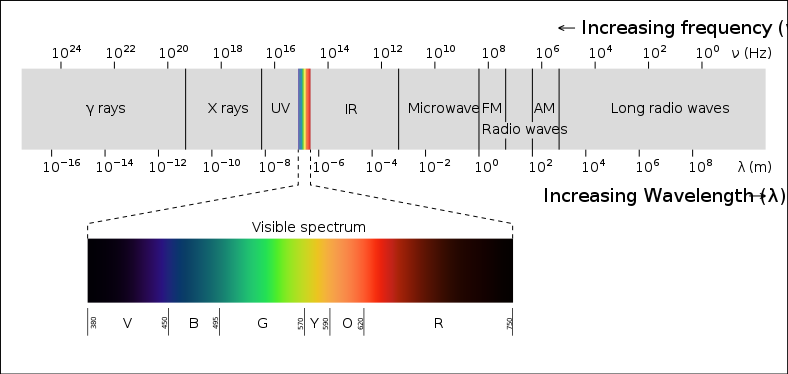
The “rainbow” that we see is the PAR light. Plants use each end of the visible light spectrum for specific growth functions. They use the blue light during its formative growth phase; seedling and root development, are all powered by blue light (400-490 nanometers). Red light is used later in a plant’s life, during its flowering and fruiting phase (580-700 nanometers).
When you’re using grow lights, they are replicating the full-spectrum of wavelengths that your plant needs to grow properly.
What Color Grow Lights Should I Use?
Natural sunlight contains the full spectrum of colors. Since we’re trying to mimic sunlight, it’s best to get lights that are the closest to copying the sun. They’re be marketed as “full-spectrum” Lights. Lighting produced by full-spectrum grow lights will best replicate the sun’s rays. These bulbs will provide both cool and warm light that will encourage seedling growth.
Are LED Lights Good for Seedlings?
Yes! And as a matter of fact, I would recommend LED lights over other options, such as fluorescent lights. While both sources of light do provide full-spectrum lighting needed for plant growth, the benefits of LED lights far outweigh fluorescent lights.
Here are but a few of the benefits of LED lights:
- They provide extra blue light, which encourages greater root growth and photosynthesis
- LED lights use half the energy of fluorescent lights, but last 5x longer
Fluorescent grow lights are not bad at all, and make a fantastic second choice when LED lights are not available. If you’ve already purchased fluorescent, do not fret. However, I would place LED lights at number one for growing vegetables.
What Grow Lights Should You Use For Vegetables?
For a gardener who is starting out with grow lights, the ideal choice should be LED, full-spectrum lights.
Fluorescent lights are also an acceptable choice. Though in the long run, fluorescent is economically and environmentally inferior to LED lights. LED lights require less energy, yet last significantly longer than fluorescent lighting. In addition, LED lighting is more sustainable to dispose of, which I’m sure we can all agree is a huge benefit. Fluorescent lighting can easily break and shatter, resulting in it being destined to take up space in a landfill.
As you grow and gain more experience, it might be of benefit to invest in more professional lighting setups. You can even purchase lights that have specific niches for your plant’s growth.
Metal halide bulbs are a popular option during a seedling’s vegetative phase. These lights expel much more blue light. As we have mentioned previously, blue light is used by plants for root development and photosynthesis.
High-pressure sodium bulbs can be used during the entirety of a plant’s life, but they’re especially helpful during a plant’s fruiting and flowering phase. If you intend on branching out into growing vegetables entirely indoors, these might be worth your while. High-pressure sodium bulbs put out significant amounts of red and orange light, which we know encourages fruit and flowers.
Both metal halide bulbs and high-pressure sodium bulbs can emit an impressive amount of light, while also keeping your electric bill pleasantly low.
How Many Hours A Day Should Seedlings Be Under Grow Lights?

The length of time you should allow your vegetable seedlings to sit under grow lights each day is around 12-14 hours a day. A lack of light will cause the seedlings to turn pale. The idea of using grow lights is to provide similar lighting to sunlight, which on average is around 12 hours a day.
Conversely, you want to make sure your seedlings get some time in the dark each day. When it’s dark, plants undergo respiration. When plants are allowed to respirate, they perform necessary biological functions that improve its overall growth rate.
Remember, you’re trying to replicate the sunlight, so you’ll need to replicate nighttime as well. Humans use the nighttime to rest and recharge, and plants do too; they’re living things after all.
Many gardeners opt to purchase a power strip that comes equipped with a timer. Having a timer will take a load off your mind, instead of wondering if the seedlings had enough light for the day.
When Should You Stop Using Grow Lights?
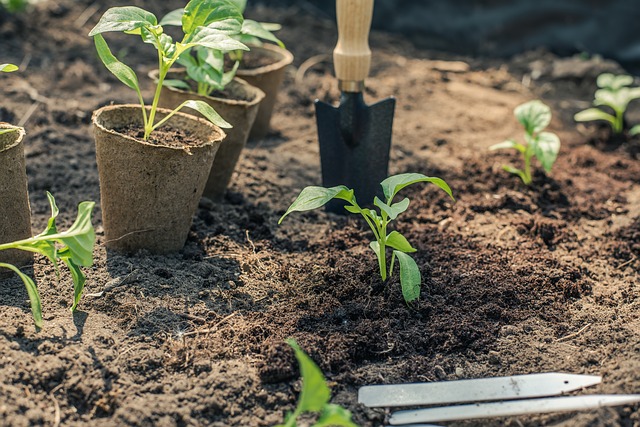
When your seedlings have reached the appropriate maturity to be transplanted outside, it’s time to start waning them off the grow lights and begin acclimating them to the outside elements. This process is known as hardening off your seedlings.
When are the seedlings mature enough to be transplanted? Ideally, you’ll want to transplant your seedlings when they have developed two sets of true leaves. For a helpful and informative guide, you can read more in our article hardening off your seedlings.
Frequently Asked Questions
What Else Can You Use Grow Lights For?
While we’ve focused on vegetable seedlings for this article, it is worth mentioning that you can use grow lights for much more than just seed starting.
Here are some other ways you can get use out of your grow lights:
- Growing herbs and micro greens during the winter: Snowing outside? No worries here! You can continue having a bountiful harvest of herbs and lettuce with the help of a grow light, even when it’s too cold to sustain life outside. I recommend trying your hand at microgreens – which is just vegetable harvested vegetable seedlings. You could try lettuce, beets, kale, broccoli, mustard or pak choi to name just a few. You’ll find the leaves are tasty and tender and you might just end up preferring them to any other mature greens you can grow.
- Indoor gardening: Growing plants from start to finish entirely indoors might seem like a difficult task to undertake, but having grow lights in your arsenal make all the difference! With a proper set up, you can grow full sized container plants in your own home using grow lights. This can be extremely convenient for gardeners who may not live in a location that provides adequate sunlight and weather conditions to sustain a vegetable garden outdoors.
Should I Give the Same Light Intensity to All of My Plants?
The short answer is: it depends.
Light intensity is based on two factors; the brightness of the lightbulb combined with how close the plant is to the grow lights. As we all know, different plants require different growing conditions, therefore, different light intensities.
Light intensity mostly boils down to the plant’s native climate. For example, plants that are native to sunny, dry climates require a more intense light whereas plants that are accustomed to dark rainforests prefer a less intense light.
Regardless, for most vegetable seedlings, I recommend you give your seedlings a more intense light source, about 6 to 10 inches (15-25cm) away from the plants.
What Wattage Lighting Do I Need for My Grow Lights?
An ideal wattage is about 20 to 40 watts of light per square foot. I would recommend planning out where you’re going to place your seedlings first, and measure how much square footage that is. Preparation is key in this situation.
If you’re purchasing your fixtures and your light bulbs separately, you must be absolutely sure that the wattage of the lightbulb is compatible with the fixture you’ve purchased. Incompatible bulbs and fixtures can lead to serious safety hazards, including overheating and fires.
Conclusion
I hope this article about grow lights has enlightened you on how helpful they are for starting your vegetable seedlings indoors. The inclusion of grow lights in your garden planning for the season will ensure you are growing sooner and eating earlier from your garden than you would be without them. So which vegetables would you love to start under grow lights this season?
Recommended Products:
Super Sprouter Deluxe Propagation Kit
Further Reading
- Where to Buy Seeds Online: Herb, Vegetable and Heirloom Seeds
- 11 Herbs to Grow Indoors (and How to Grow Them)
- Best Indoor Vegetable Garden Growing System
- Best Indoor Herb Garden Kit
